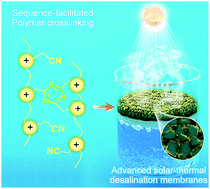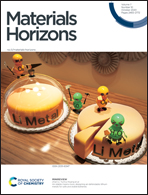A cationitrile sequence encodes mild poly(ionic liquid) crosslinking for advanced composite membranes†
Abstract
Polymer crosslinking is crucial for the preparation and consolidation of hierarchical nano- and micro-structures, hybrid interfaces, and collective assemblies. Here, for the first time, we showed that a “cation–methylene–nitrile” (CMN) functionality sequence encoded within repeating units of poly(ionic liquid)s (PILs) allowed for mild cyclizations of nitriles, processes otherwise requiring high temperatures and harsh catalysts. These new reactions facilitated by the CMN sequence were readily translated into freestanding nanomembranes (∼19 nm in thickness) and nanocomposite membranes by treating the PILs with mild ammonia vapor (0.2 bar, 20 °C). These materials were observed to be stable in various solvents, at different pH levels, and even in boiling water, exhibiting exceptional mechanical strength and solar-thermal desalination performance. The sequence was easy to synthesize, transferable in copolymers, and applicable to various cations, such as imidazolium, pyridinium, and triazolium. We expect it to provide a molecular code promoting programmable polymer crosslinking and the formation of hybrid structures for sustainable energy and water applications.



 Please wait while we load your content...
Please wait while we load your content...